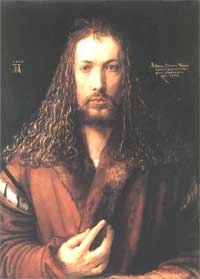Albrecht Dürer - Return to Nuremberg
Albrecht Dürer returned from his journey to Venice in the spring of the year 1495.

Self-Portrait in a Fur-Collared Robe 1500
Alte Pinakothek, Munich
When not busy executing commissions, he made copies of engravings by Italian artists, among them Mantegna. He devoted a lot of his time to the study of nature, making studies of the nude, animal and still life, as he believed that "the one test of an artist's conceptions is nature."
His first commission came from Frederick the Wise, Elector of Saxony. The subject was the altarpiece for the Church in Wittenberg Castle, representing the Virgin and Child, St. Anthony and St. Sebastian, now in the Gemäldegalerie, Dresden. At the same time, he made the portrait of Frederick, now in the Staatliche Museen, Berlin.
From 1497 dates the "Portrait of a Young Fürleger with Her Hair Done Up", some authors identifying the young lady as being Katharina Fürleger. The work is now in Staatliche Museen, Berlin. In the same year he painted the portrait of his father, now in The National Gallery, London, and in 1498 the half length self portrait which is in the Prado. Between 1496 and 1498, Dürer made the series of fifteen large woodcuts of the Apocalypse.
In 1499, the artist painted the three portraits of the Tucher family members, Hans and his wife Felicitas, in Weimar Schlossmuseum, and his sister-in-law, Elsbeth, in Staatliche Kunstsammlungen, Kassel. The portrait of Oswald Krell, in the Alte Pinakothek in Munich, dates from the same year.
In 1500, the artist made his famous "Self-Portrait in a Fur-Collared Robe", now in the Alte Pinakothek, Munich. In the same year, Dürer painted the altar-piece, now in the same Munich gallery, which represents the “Lamentation for Christ”. The Pietà (The Lamentation ), now in the Germanisches National Museum, dating from the same period, resembles it closely, with the difference that there are fewer people in the composition.
In 1502, the artist’s father died. He did not leave much in support of his family, and soon his mother spent everything she had. Albrecht took care of her and his twelve years old brother Hans, whom he started to educate as a painter. The other brother, Andreas, decided to follow the goldsmith trade, and left for his Wanderjahre about that time.
Dürer's love and care for his mother was immense. He always had a childlike attitude towards his parents, and, when they were not anymore, he kept the same spiritual obedience and reverence for them.
In 1503, the artist painted the Paumgärtner Altar, also in the Alte Pinakothek in Munich. The "Madonna Nursing the Child," in Kunsthistorisches Museum,Gemaeldegalerie, Vienna, done in the same year, through its beauty of expression, and the way the flesh is treated, reveals an Italian influence. We may relate the style to the influence of the Venetian painter Jacopo de' Barbari, who established his workshop in Nuremberg in 1500.
In the next year, 1504, on a commission from Elector Frederick the Wise, Dürer painted the "Adoration of the Magi," now in the Galleria degli Uffizi, Florence. From this same year dates a series of twelve scenes from the Passion, drawn on paper tinted green, and known, therefore, as the "Green Passion." They are now in the Graphische Sammlung Albertina, Vienna.
Next - Second Journey to Venice
